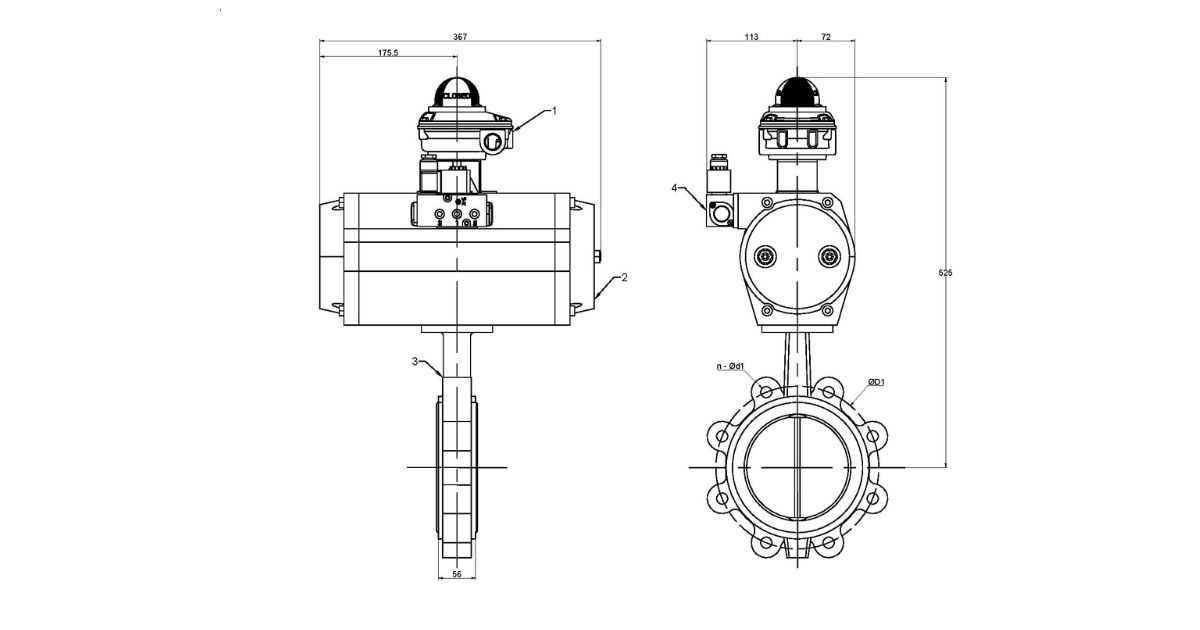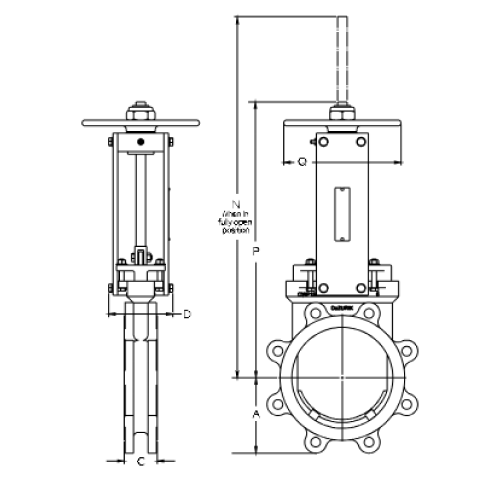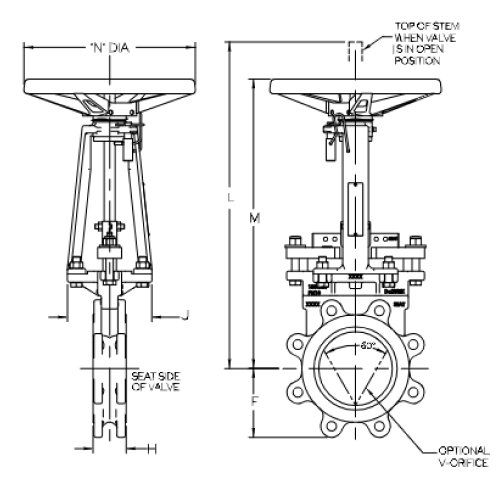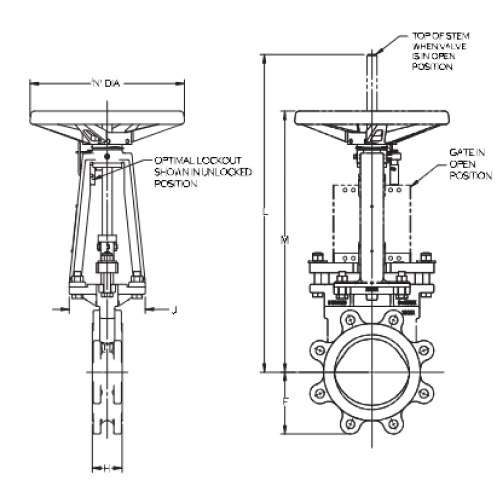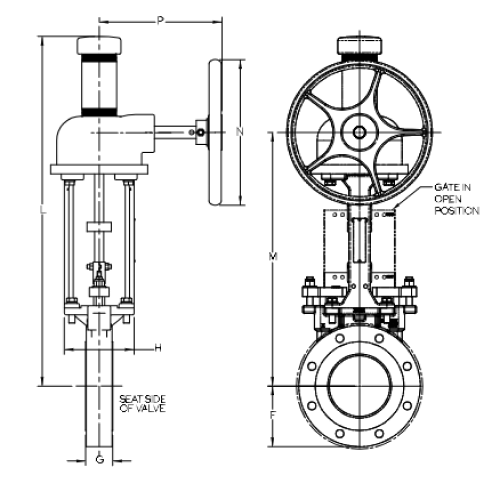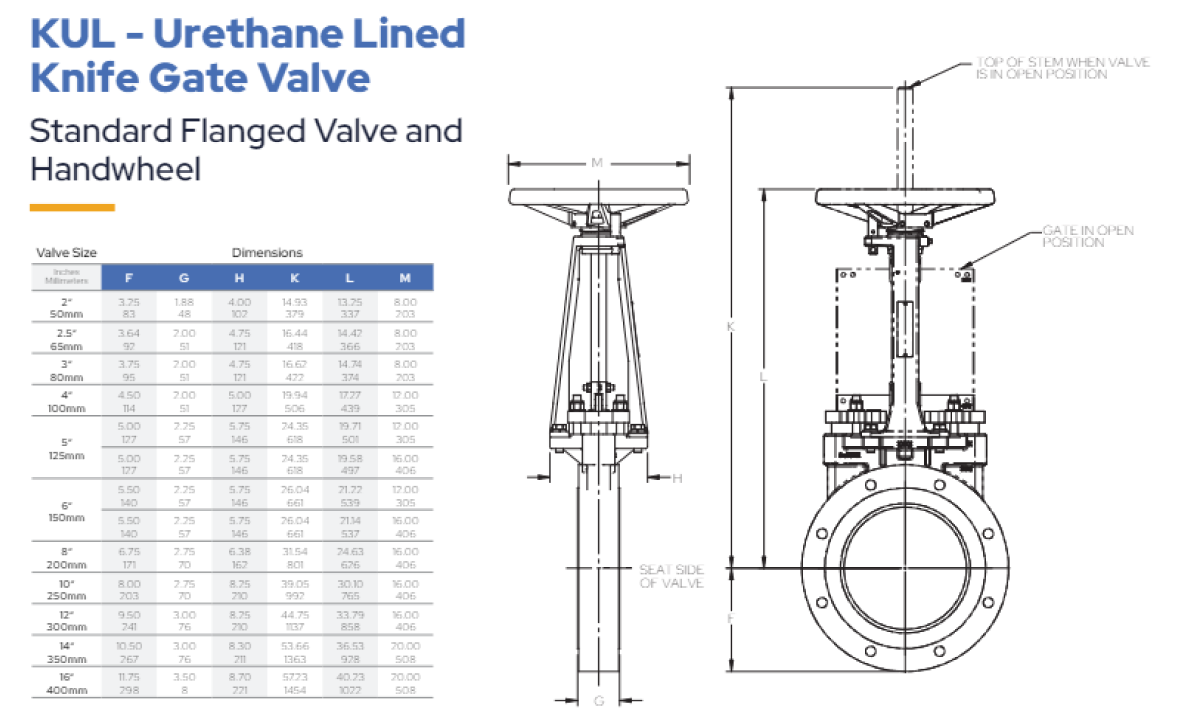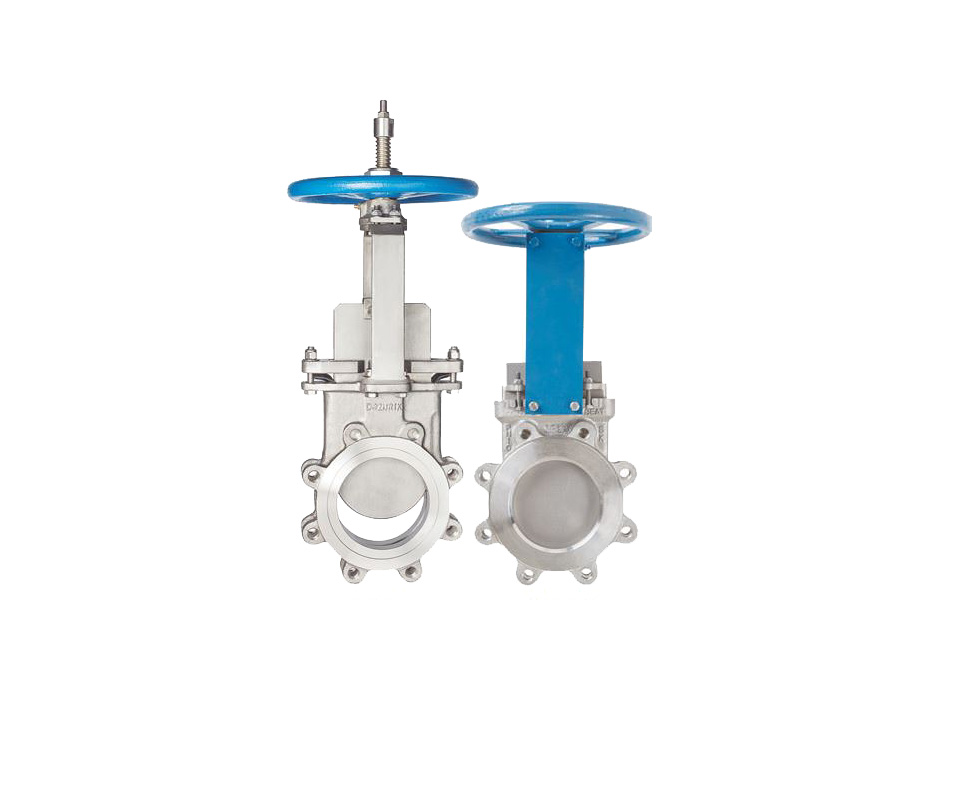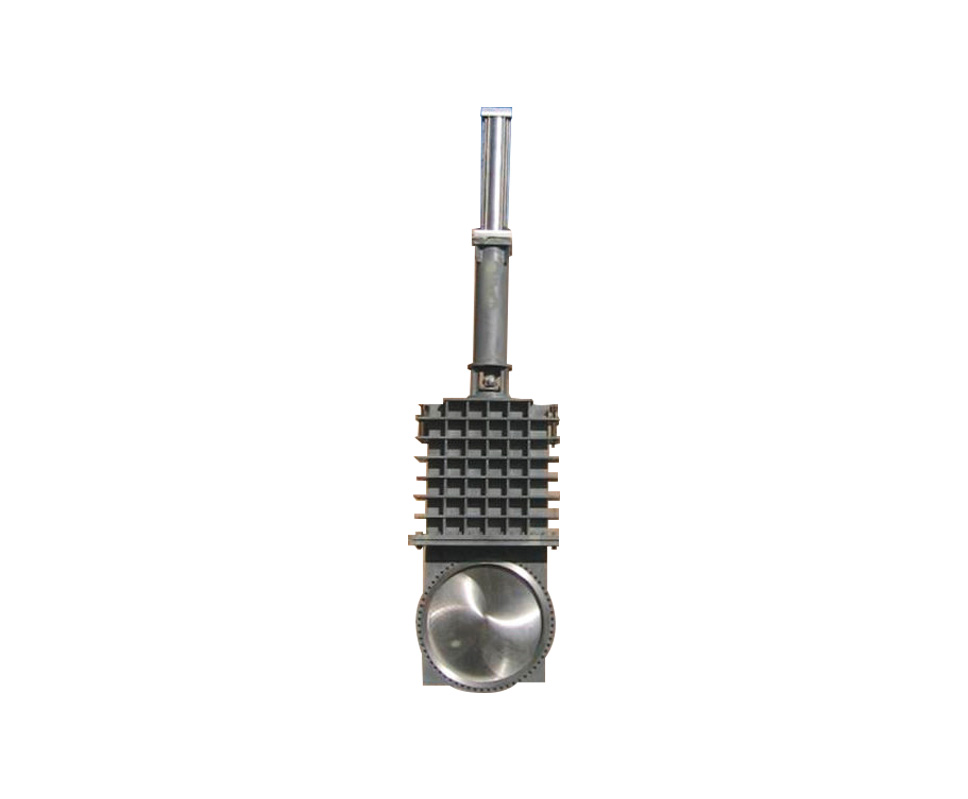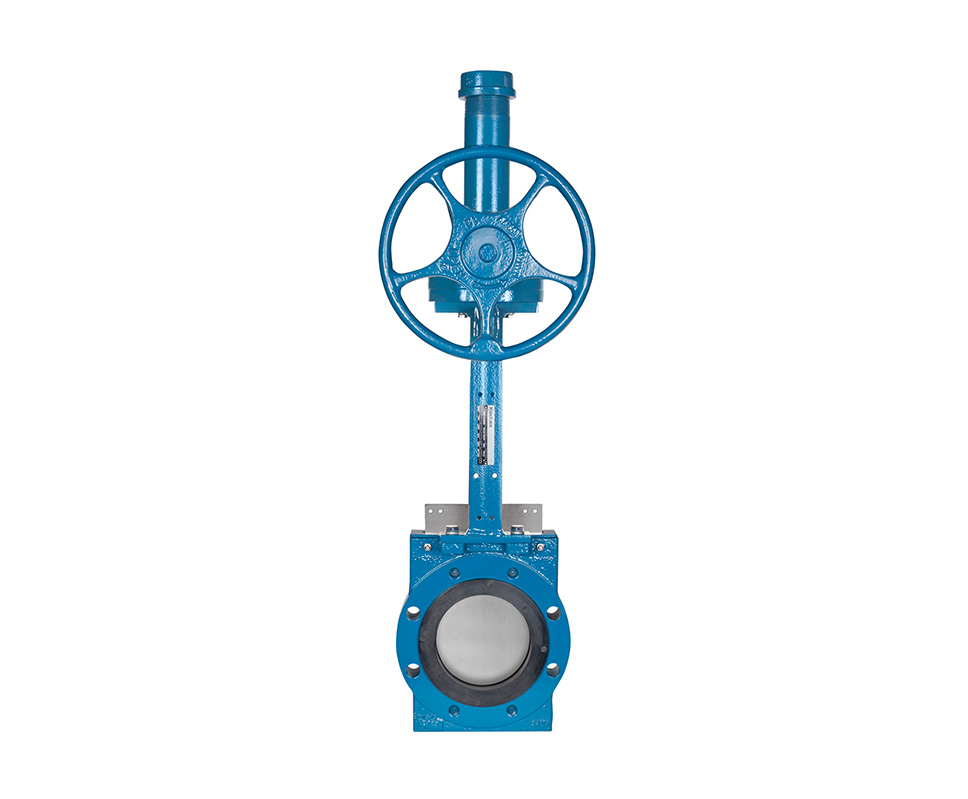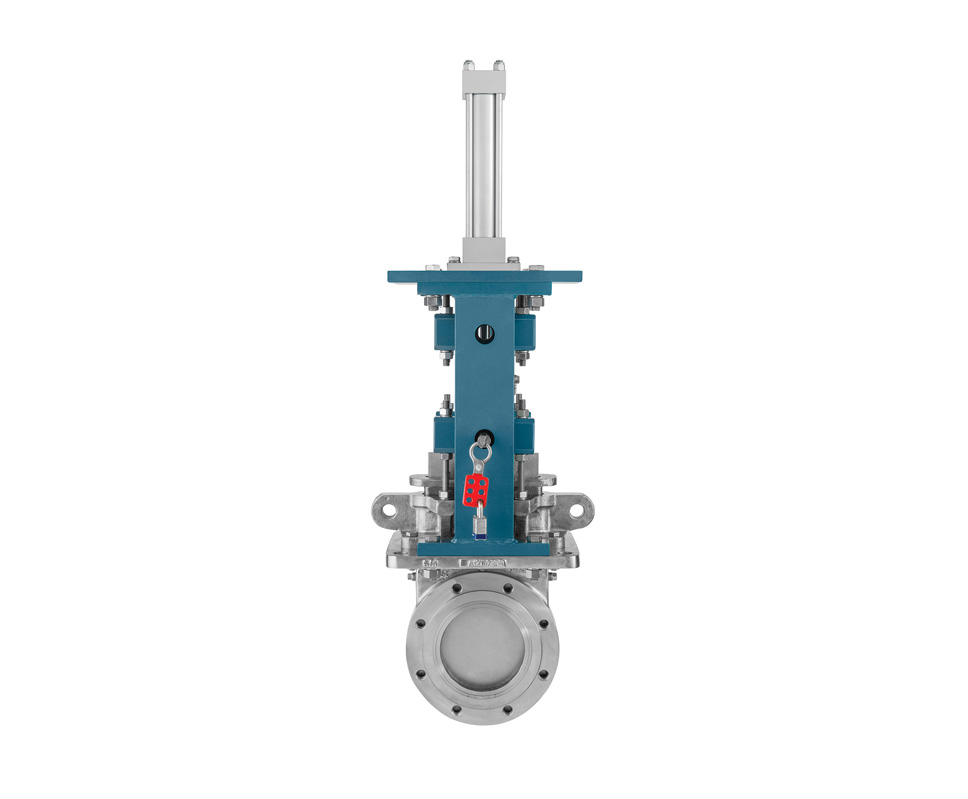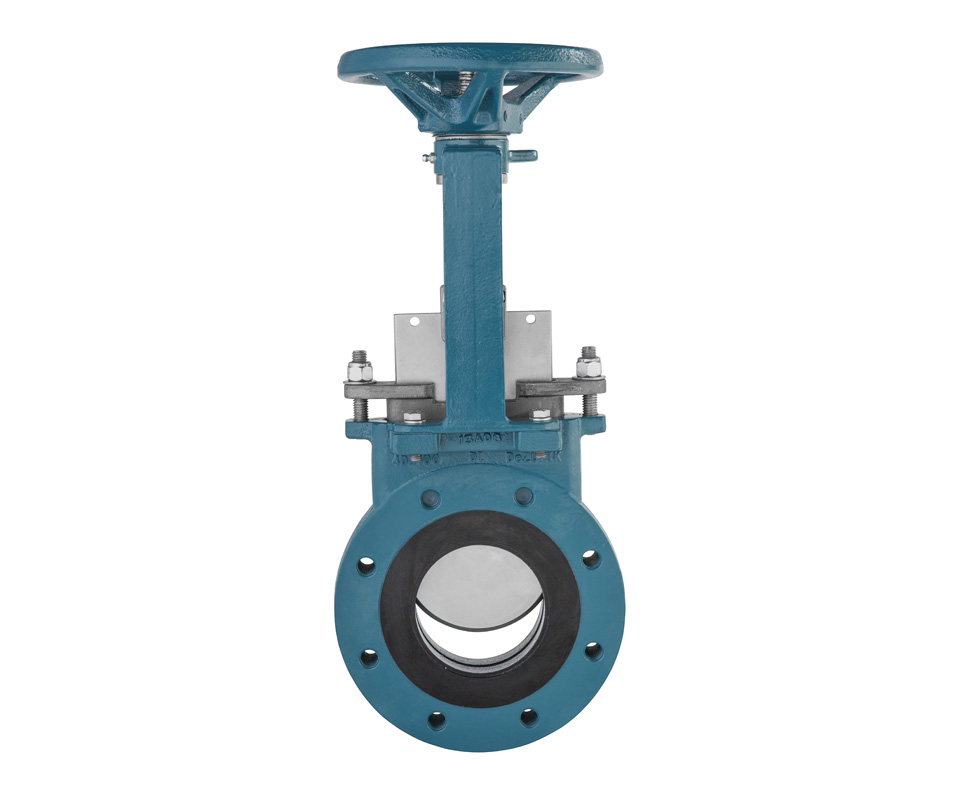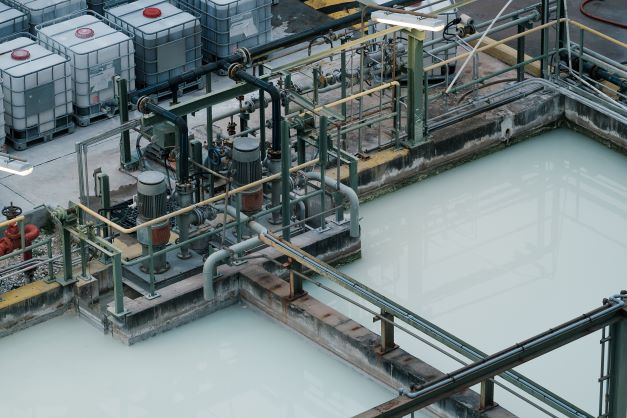Knife Gate Valves Resource Guide for Engineers
Here you will find all the essential information you need when consulting a valve specialist to specify knife gate valves for your mining project.
REQUEST SPECIFICATION SUPPORT
Request Specification Support
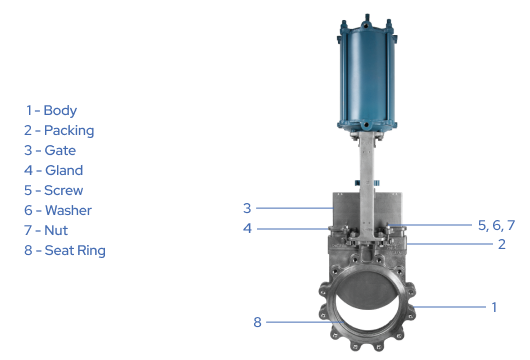
DeZURIK KGC-ES Extended Service Life Cast Stainless Steel Knife Gate Valve
The Anatomy of a KGC Knife Gate Valve
DeZURIK's KGC Stainless Steel Knife Gate Valves are designed as reliable isolation/on-off solutions for challenging applications handling corrosive, abrasive liquids, slurries, or dry materials. Featuring a standard pressure rating of 150 psi CWP, these valves offer versatility with three distinct body styles:
1. ES Extended Service Knife Gate Valves (Sizes DN50-DN1200): Designed to withstand temperatures up to 540°C, featuring DeZURIK's premium packing system with options for metal or unidirectional resilient seats.
2. MD Maximum Duty Knife Gate Valves (Sizes DN80-DN600): Equipped with DeZURIK's premium packing system, offering hardened metal seats and choices for dual metal/resilient seats, ideal for high-demand scenarios up to 260°C.
3. BD Bi-Directional Knife Gate Valves (Sizes DN25-DN900): Engineered for temperatures up to 205°C, featuring premium packing systems and bi-directional perimeter seats for direct and reverse shutoff.
Compliant with AIS American Iron & Steel provisions for H.R. 3547, these valves meet specific requirements for projects involving Clean Water State Revolving Funds (CWSRF) or Drinking Water State Revolving Funds (DWSRF), ensuring adherence to regulatory standards.
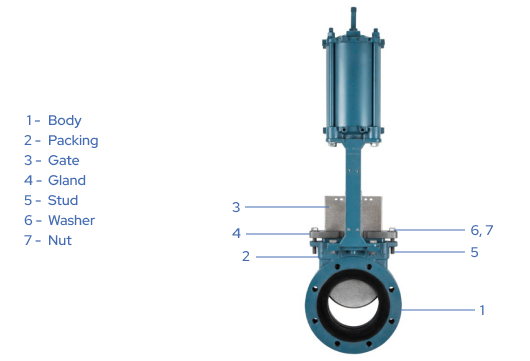
DeZURIK KUL Urethane Lined Knife Gate Valve - Standard Flanged Body
The Anatomy of a Urethane Lined (KUL) Knife Gate Valve
DeZURIK's KUL Urethane Lined Knife Gate Valves are purpose-built for managing abrasive slurry and dry materials, catering specifically to the demands of industries like mining, chemical processing, and food production. Available in various sizes — ranging from DN50-DN1200 for standard flanged valves and from DN50-DN300 for grooved end valves — these valves offer versatility in application.
Designed to endure harsh conditions, these valves feature a robust construction of cast ductile iron complemented by a bonded urethane liner. This construction ensures a secure, tight seal even in challenging environments, offering pressure ratings up to 150 or 250 psi (1030 or 1720 kPa) CWP. Additionally, they operate within a temperature range from -29º C to 130º C, using specific urethane liner compounds tailored to varying application needs.
The enclosed design of DeZURIK's KUL valves prevents environmental discharge during valve operation and ensures a sealed operational environment. The seamless urethane liner enhances abrasion resistance and acts as the valve's flange gasket, further bolstering its durability and performance.
The KUL-EF has an extended flange designed to match the face to face dimensions of long-bodied 'push-through' style slurry valves, and a non-discharging design without making piping modifications for install. Size ranges from DN50-DN1200, with pressure rating to 17.2 Bar. Minimum body wall thickness per ASME B16.346.34 and full faced flanged ASME150, AS2129 Table D and E Drilling available.
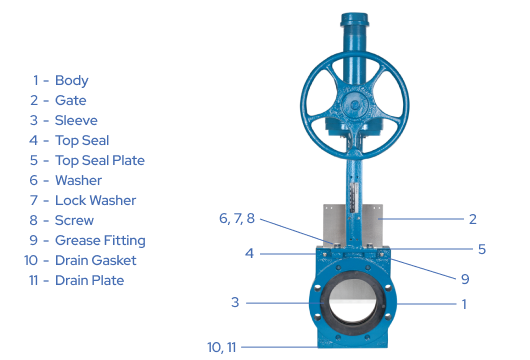
DeZURIK KSL-SD Slurry Knife Gate Valve
The Anatomy of a KSL-SD Slurry Knife Gate Valve
DeZURIK's KSL-SD Slurry Knife Gate Valves are precision-engineered for on-off (isolation) operations in handling abrasive, high solids content, wet, or dry media. Specifically designed for mining, power, and aggregate industries, these valves feature a short body design in line with MSS SP-81 standards.
Available in sizes from DN50-DN600, with larger sizes upon request, these valves offer temperature ratings up to 81°C as standard, extendable to 150°C with optional seat materials. Pressure ratings vary: 150 psi CWP (1030kPa) for DN50-DN400 valves, 100 psi CWP (690 kPa) for DN400-DN600 valves, with options for higher pressures using specific gate materials.
With a choice of cast body materials like Ductile Iron, Carbon Steel, Stainless Steel, or higher alloy options, these valves integrate several innovative features. They adhere to industry standards such as ASME B16.5 Class 150, DIN, ISO, BS, AS, and SANS, ensuring bi-directional, drip-tight shutoff at full pressure.
The design minimises maintenance concerns and enhances operational efficiency. Featuring a full port design, they reduce turbulence and pressure drop while eliminating spaces where solids might collect. Unique sleeve compression eliminates gate and stem packing, and the need for flange gaskets. Optional gate coatings offer superior abrasion resistance and a non-stick surface, reducing actuating forces and extending sleeve life.
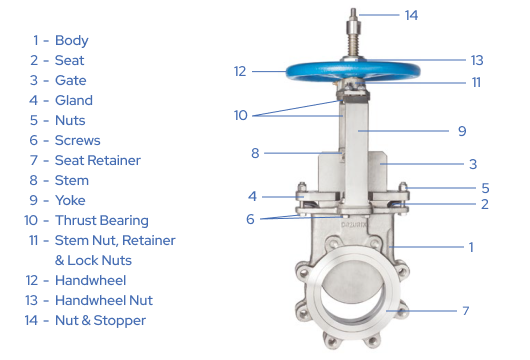
DeZURIK KGN-RSB Bi-Directional Cast Stainless Steel Knife Gate Valve
The Anatomy of the KGN-RSB and KGN-MSU Knife Gate Valves
DeZURIK KGN Knife Gate Valves are available as a bi-directional resilient seated valve (KGN-RSB) and a unidirectional metal seated valve (KGN-MSU).
The KGN-RSB is designed for corrosive, abrasive liquid applications across industries like Pulp & Paper, Mining, Wastewater, Chemical, Petrochemical, Power, and Steel. It provides a tight seal in both directions, ensuring secure isolation.
On the other hand, the KGN-MSU is ideal for handling corrosive liquids, slurries, or dry materials in similar industries, offering precise unidirectional flow control.
Key features include a robust stainless steel body, gate, stem, and optional carbon steel in metal-seated valves, ensuring durability in harsh conditions.
These valves are crucial in industries requiring efficient fluid control amid corrosive and abrasive elements, serving as reliable solutions for demanding operational environments.
Heavy Industry Valve Drawings for Specification Engineers
Discover the Versatility of Knife Gate Valves in Slurry, Tailings, Water Treatment, and Mineral Processing Applications
The Valve Company was engaged as a key supplier for the Wiluna Gold Mine project in the Goldfields, WA. We stock and supply valves for their open-pit gold mining operation. The scope encompassed a wide range of valves, such as manual ball, butterfly, diaphragm, check, float valves & knife gate valves; actuated butterfly and ball valves.
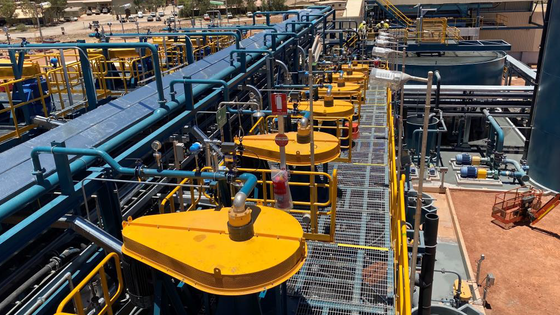
The Warrawoona syncline is one of the largest greenstone-hosted goldfields in the East Pilbara. Commissioning of the processing circuit commenced in April 2022, with the mine officially producing gold in early May 2022. TVC was engaged to supply a range of valves for the project, such as manual ball, butterfly, diaphragm, check, float valves & knife gate valves; actuated butterfly and ball valves.
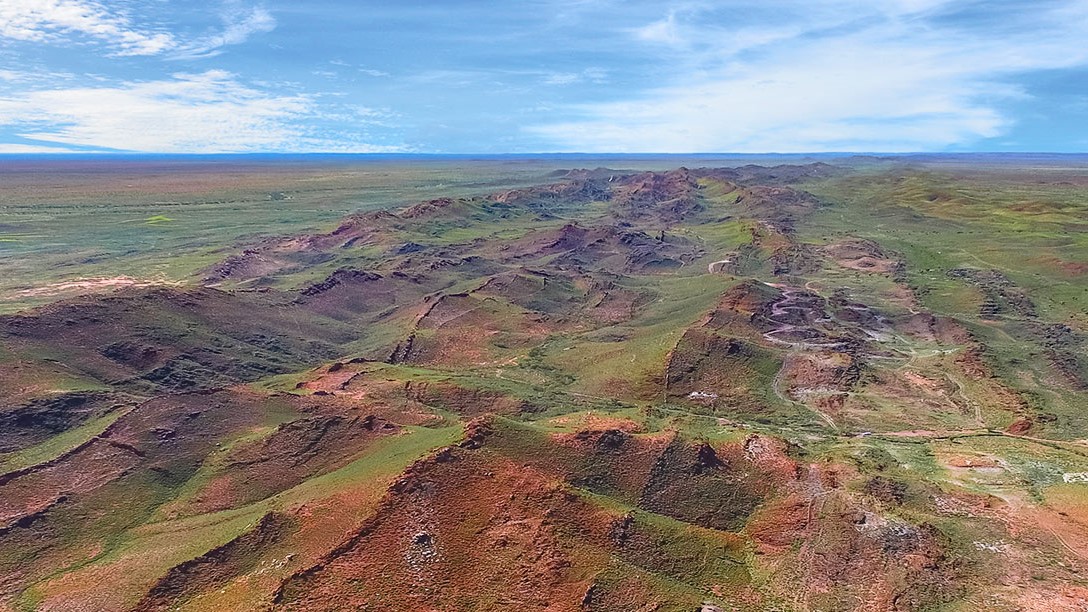
The proposal of the Thunderbird project is for a mineral sands operation with an estimated 40-year life of mine. Mineral products are to be mined from the Thunderbird Deposit and processed onsite before being transported by road to the Derby Wharf for storage and subsequent export. Engaged to supply valves to the project, TVC sourced a range of products, such as manual ball, butterfly, diaphragm, check, float valves & knife gate valves; actuated butterfly and knife gate valves.
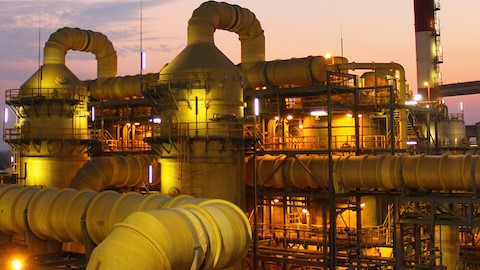
The Thunderbox gold project includes the Thunderbox, Rainbow, and Otto Bore gold deposits in Western Australia, and it is considered to be one of the most significant gold deposits discovered within the last 20 years in Australia. TVC was engaged to supply a range of valves to the project, such as manual ball, butterfly, diaphragm, check & float valves; PVC valves; actuated butterfly and knife gate valves.
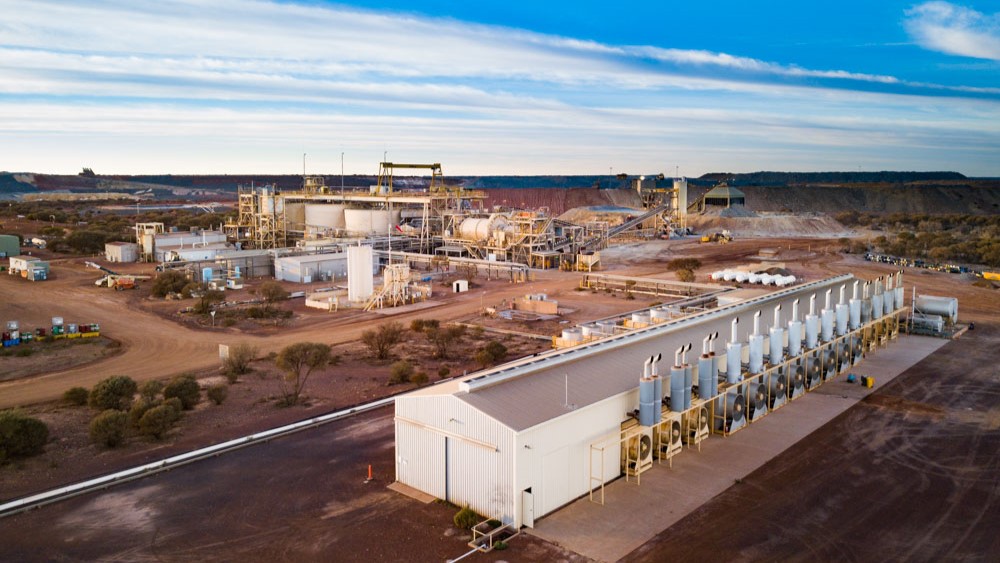
TVC was engaged to supply valves for the Cosmos Nickel Complex Project in WA. The project is a large-scale undertaking that requires precise control and regulation of fluid and gas flow. The scope of supply included manual ball, butterfly, diaphragm, check, float valves and knife gate valves, as well as actuated butterfly, globe control and knife gate valves.
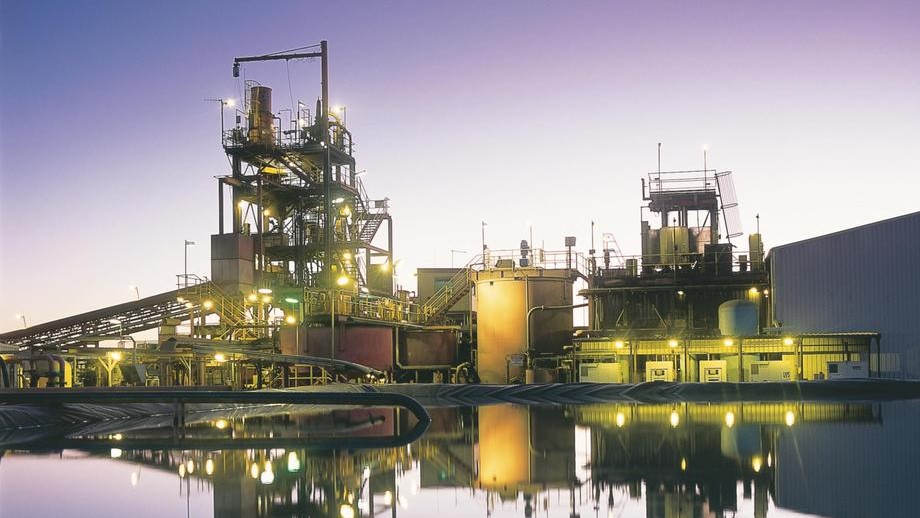
TVC was engaged as the supplier of actuated knife gate valves for the Carosue Dam Project, ensuring smooth mining processing operations of high-grade gold and nickel deposits in Laverton, Western Australia.
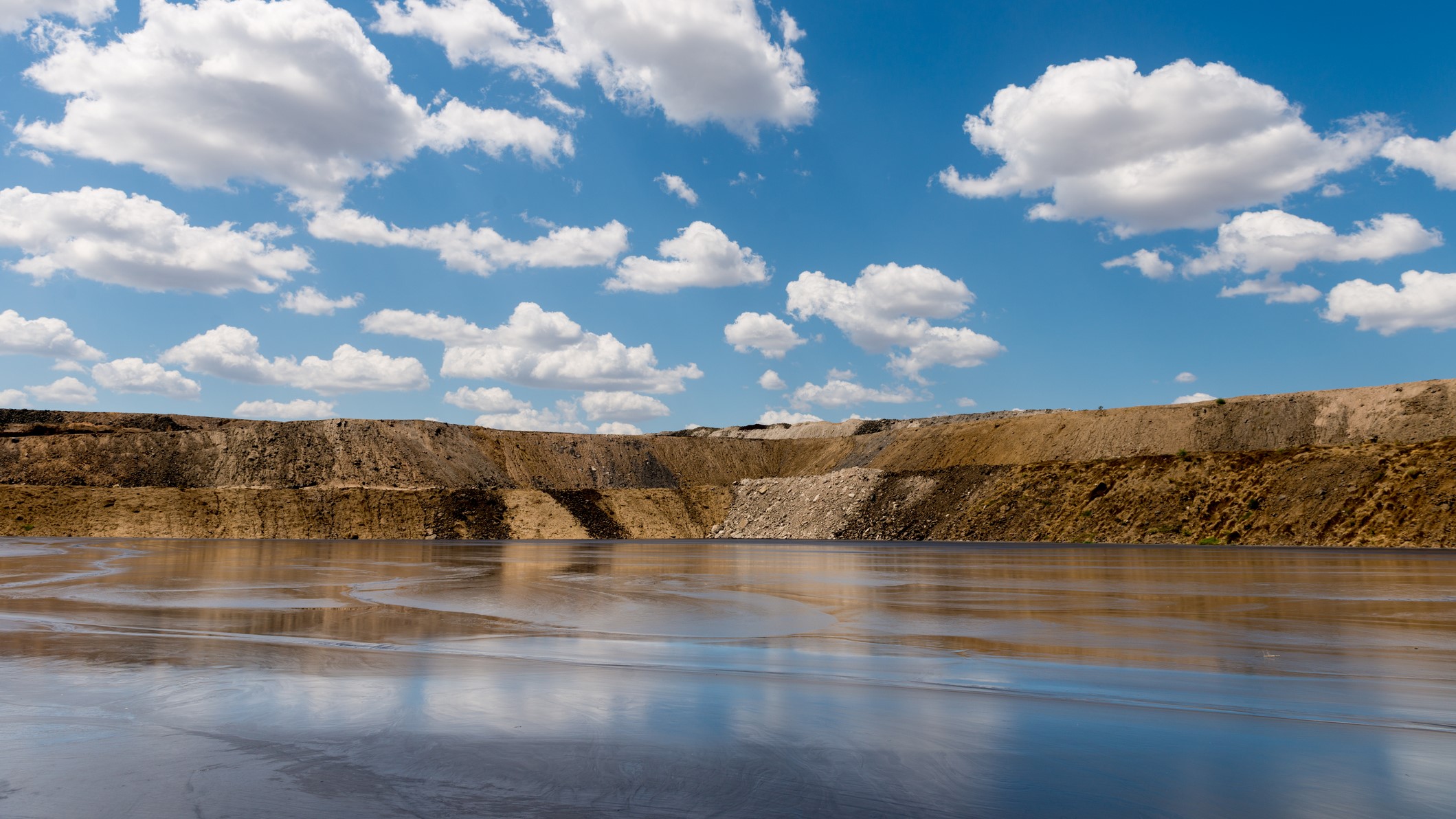
The Lake Way project in Wiluna, WA involves exploring and developing gold and base metal deposits. The Valve Company was contracted to supply a range of high-performance valves for the project, such as manual ball, butterfly, diaphragm, check, float valves & knife gate valves; actuated butterfly, globe control and knife gate valves.
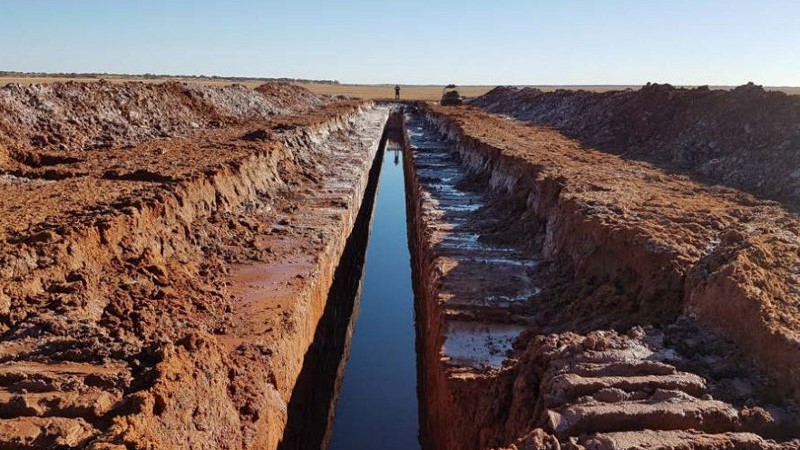
Salt Lake Potash is a mining project that aims to extract hypersaline brine from the Goldfields region of Western Australia to produce sulphate of potash. The Valve Company is a key supplier in this project providing from manual ball, butterfly, diaphragm, check, float valves & knife gate valves; to actuated butterfly, globe control and knife gate valves.
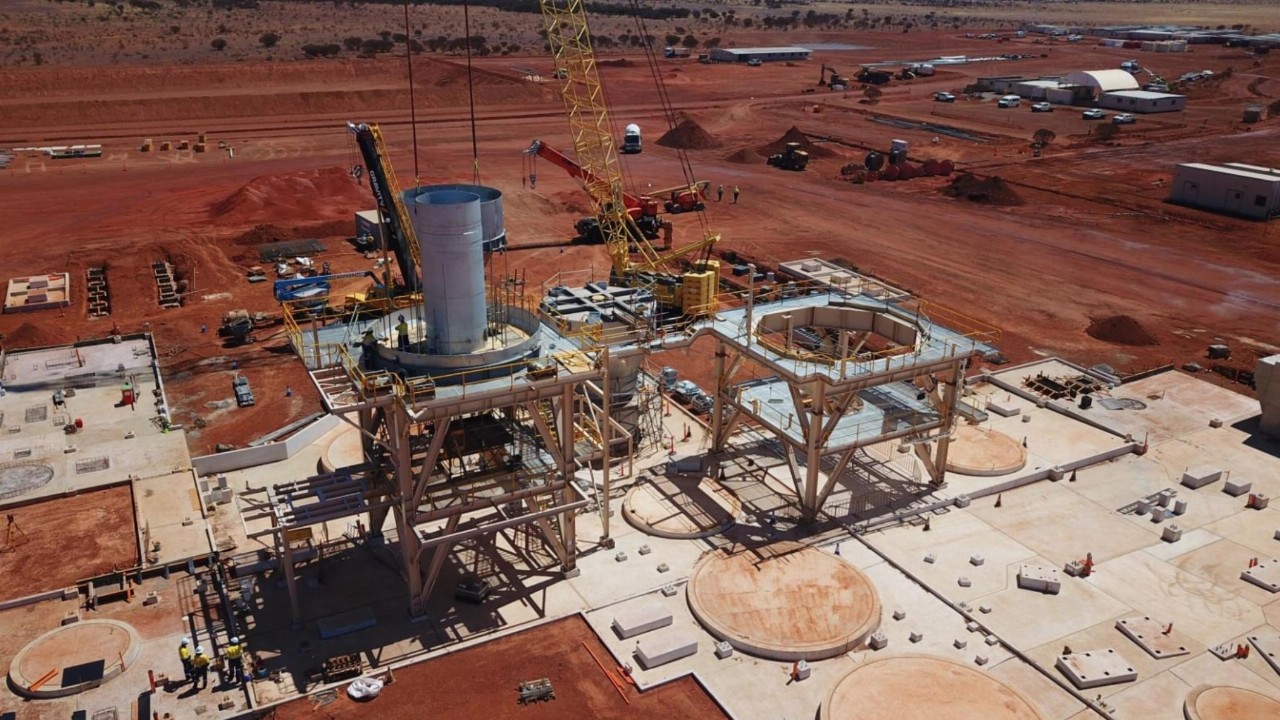
The project hosts the historical Honeymoon Uranium Mine, which was Australia's second operating in-situ recovery uranium mine.
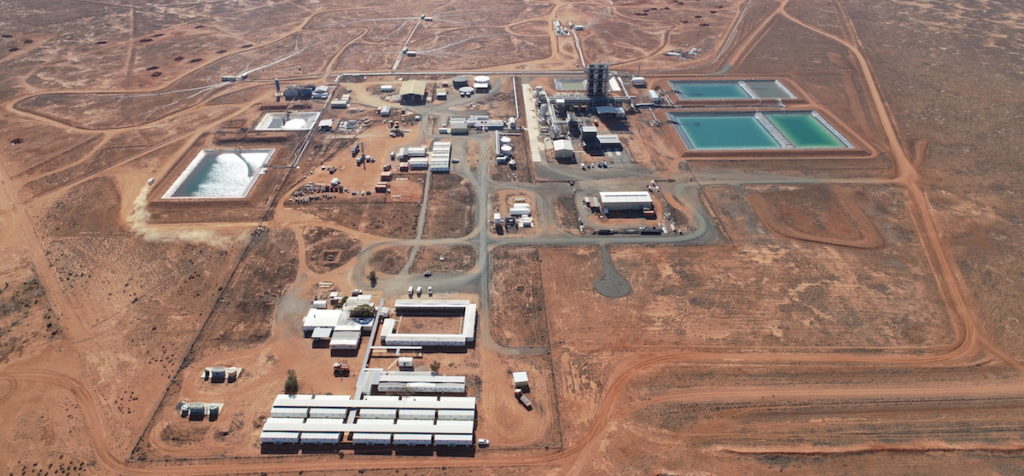
Stanhope will process up to 54,000 tonne per annum of organic and agricultural waste streams for the generation of 1.2MW baseload renewable electricity exported to the grid.
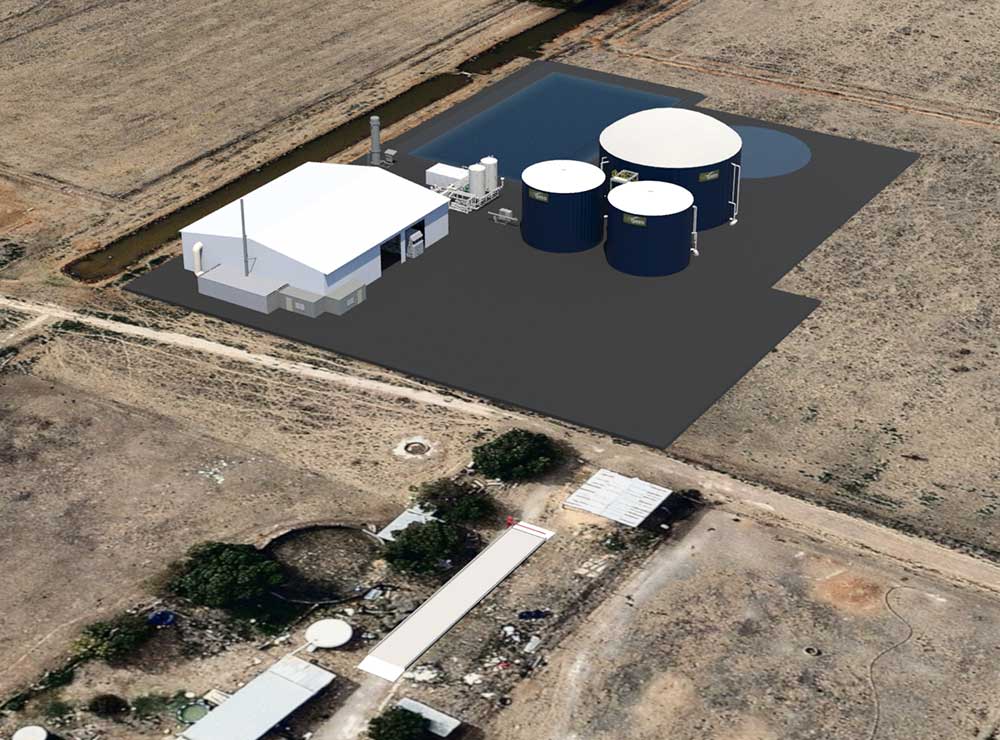
Valve General Arrangement Drawings & Recommended Reading
KNIFE GATE VALVES REFERENCE LIBRARY
 Polymer Handling Valves for Petrochemical Polymer Manufacturing
Polymer Handling Valves for Petrochemical Polymer Manufacturing.png)
 Understanding Why Bonded Urethane Liner Provides Superior Performance
Understanding Why Bonded Urethane Liner Provides Superior Performance.png)
 DeZURIK KGC-BD Bi-Directional Cast Stainless Steel Knife Gate Valve
DeZURIK KGC-BD Bi-Directional Cast Stainless Steel Knife Gate Valve.png)
 DeZURIK AIS Compliant KGC-BD BI-Directional Cast Stainless Steel Knife Gate Valve
DeZURIK AIS Compliant KGC-BD BI-Directional Cast Stainless Steel Knife Gate Valve.png)
 DeZURIK KGC-ES Extended Service Life Cast Stainless Steel Knife Gate Valves
DeZURIK KGC-ES Extended Service Life Cast Stainless Steel Knife Gate Valves.png)
 DeZURIK KGC-MC Metal Cutting Cast Stainless Steel Knife Gate Valves
DeZURIK KGC-MC Metal Cutting Cast Stainless Steel Knife Gate Valves.png)
 DeZURIK KGC-MD Maximum Duty Cast Knife Gate Valve
DeZURIK KGC-MD Maximum Duty Cast Knife Gate Valve.png)
 DeZURIK KGN-MSU Metal Seated Cast Stainless Steel Knife Gate Valve
DeZURIK KGN-MSU Metal Seated Cast Stainless Steel Knife Gate Valve.png)
 DeZURIK KGN-RSB Bi-Directional Cast Stainless Steel Knife Gate Valve
DeZURIK KGN-RSB Bi-Directional Cast Stainless Steel Knife Gate Valve.png)
 DeZURIK KSL-LA Slurry Knife Gate Valves
DeZURIK KSL-LA Slurry Knife Gate Valves.png)
 DeZURIK KUL Urethane Lined Knife Gate Valves in Hydrocyclones (Primary Separation Cell)
DeZURIK KUL Urethane Lined Knife Gate Valves in Hydrocyclones (Primary Separation Cell).png)
 DeZURIK KUL Urethane Lined Knife Gate Valves
DeZURIK KUL Urethane Lined Knife Gate Valves.png)
 DeZURIK NXS Packing System for KUL Urethane Lined Knife Gate Valves
DeZURIK NXS Packing System for KUL Urethane Lined Knife Gate Valves.png)
 DeZURIK KGC Cast Knife Gate Valve - Safety Manual
DeZURIK KGC Cast Knife Gate Valve - Safety Manual.png)
 DeZURIK Lockout Device for Knife Gate Valves
DeZURIK Lockout Device for Knife Gate Valves.png)
 DeZURIK KSL-SD Slurry Knife Gate Valves
DeZURIK KSL-SD Slurry Knife Gate Valves.png)
 DeZURIK KGC-BD AIS Bi-Directional Cast Stainless Steel Knife Gate Valves - Suggested Specification
DeZURIK KGC-BD AIS Bi-Directional Cast Stainless Steel Knife Gate Valves - Suggested Specification.png)
 DeZURIK KGC-ES Extended Service Life Cast Stainless Steel - Suggested Specification
DeZURIK KGC-ES Extended Service Life Cast Stainless Steel - Suggested Specification.png)
 DeZURIK KGC-MD Maximum Duty Cast Knife Gate Valves - Suggested Specification
DeZURIK KGC-MD Maximum Duty Cast Knife Gate Valves - Suggested Specification.png)
 DeZURIK KSL-LA Slurry Knife Gate Valve - Suggested Specification
DeZURIK KSL-LA Slurry Knife Gate Valve - Suggested Specification.png)
 DeZURIK KSL-SD Slurry Knife Gate Valve - Suggested Specification
DeZURIK KSL-SD Slurry Knife Gate Valve - Suggested Specification.png)
 DeZURIK KUL Urethane Lined Knife Gate Valves - Suggested Specification
DeZURIK KUL Urethane Lined Knife Gate Valves - Suggested Specification.png)
 DeZURIK KUL Urethane Lined Knife Gate Valves
DeZURIK KUL Urethane Lined Knife Gate Valves.png)
 DeZURIK KGN Cast Knife Gate Valve - Suggested Specification
DeZURIK KGN Cast Knife Gate Valve - Suggested Specification.png)
 DeZURIK Instructions - DYNATORQUE INC – General Maintenance and Operation Manual
DeZURIK Instructions - DYNATORQUE INC – General Maintenance and Operation Manual.png)
 DeZURIK Instructions - RDC Control Series HL, HM and HP Hydraulic Cylinder Valve Actuators
DeZURIK Instructions - RDC Control Series HL, HM and HP Hydraulic Cylinder Valve Actuators.png)
 DeZURIK Instructions - RDC Control Series PA Valve Actuators
DeZURIK Instructions - RDC Control Series PA Valve Actuators.png)
 DEZURIK 4V 4-Way Pilot Valve Used With DeZURIK Diaphragm and Cylinder Actuators
DEZURIK 4V 4-Way Pilot Valve Used With DeZURIK Diaphragm and Cylinder Actuators.png)
 DeZURIK AFR3 Filter Regulator Used on Pneumatic Cylinder Actuators
DeZURIK AFR3 Filter Regulator Used on Pneumatic Cylinder Actuators.png)
 DeZURIK KGC-BD Bi-Directional Knife Gate Valves with Guides (50-900mm)
DeZURIK KGC-BD Bi-Directional Knife Gate Valves with Guides (50-900mm).png)
 DeZURIK KGC-BD Bi-Directional Knife Gate Valve
DeZURIK KGC-BD Bi-Directional Knife Gate Valve.png)
 DeZURIK KGC-ES or -HD Knife Gate Valves (550, 650, 1200mm)
DeZURIK KGC-ES or -HD Knife Gate Valves (550, 650, 1200mm).png)
 DeZURIK KSL-SD Slurry Knife Gate Valves (50-600mm)
DeZURIK KSL-SD Slurry Knife Gate Valves (50-600mm) .png)
 DeZURIK KGC-ES Knife Gate Valves (50-600mm)
DeZURIK KGC-ES Knife Gate Valves (50-600mm).png)
 DeZURIK KGC-MC Metal Cutting Knife Gate Valves
DeZURIK KGC-MC Metal Cutting Knife Gate Valves.png)
 DeZURIK KGN-MSU Unidirectional Cast Stainless Steel Knife Gate Valves (50-900mm)
DeZURIK KGN-MSU Unidirectional Cast Stainless Steel Knife Gate Valves (50-900mm).png)
 DeZURIK KGN-RSB Bi-Directional Cast Stainless Steel Knife Gate Valves (50-600mm)
DeZURIK KGN-RSB Bi-Directional Cast Stainless Steel Knife Gate Valves (50-600mm).png)
 DeZURIK KSL-LA Long Body Slurry Knife Gate Valves (50-600mm)
DeZURIK KSL-LA Long Body Slurry Knife Gate Valves (50-600mm).png)
 DeZURIK KGC-MD Knife Gate Valves
DeZURIK KGC-MD Knife Gate Valves.png)
 DeZURIK Lockout Device for Bevel Gear Actuated Knife Gate Valves
DeZURIK Lockout Device for Bevel Gear Actuated Knife Gate Valves.png)
 DeZURIK Lockout Device for Cylinder Operated Knife Gate Valves
DeZURIK Lockout Device for Cylinder Operated Knife Gate Valves.png)
 DeZURIK Lockout Device for Handwheel Actuated KSL Slurry Knife Gate Valves
DeZURIK Lockout Device for Handwheel Actuated KSL Slurry Knife Gate Valves .png)
 DeZURIK Lockout for KSL-SD Slurry Valves
DeZURIK Lockout for KSL-SD Slurry Valves.png)
 DeZURIK Cylinder Actuator for Knife Gate Valves (April 2022)
DeZURIK Cylinder Actuator for Knife Gate Valves (April 2022).png)
 DeZURIK Manual Actuator For Knife Gate Valves (November 2013)
DeZURIK Manual Actuator For Knife Gate Valves (November 2013).png)
 Cylinder Actuator for Knife Gate Valves (February 2022)
Cylinder Actuator for Knife Gate Valves (February 2022).png)
 DeZURIK Manual Actuator for KSL-SD Slurry Valves
DeZURIK Manual Actuator for KSL-SD Slurry Valves.png)
 DeZURIK Cylinder Actuator for Knife Gate Valves - Safety Manual
DeZURIK Cylinder Actuator for Knife Gate Valves - Safety Manual.png)
 DeZURIK Repair Kit – Cylinder Actuator for Knife Gate Valves
DeZURIK Repair Kit – Cylinder Actuator for Knife Gate Valves.png)
 DeZURIK Manual Actuator for KSL Slurry Valves
DeZURIK Manual Actuator for KSL Slurry Valves.png)
 DeZURIK KGC-ES Extended Service Life Cast Stainless Steel Knife Gate Valves
DeZURIK KGC-ES Extended Service Life Cast Stainless Steel Knife Gate Valves.png)
 DeZURIK KGC-MD Maximum Duty Cast Knife Gate Valves
DeZURIK KGC-MD Maximum Duty Cast Knife Gate Valves.png)
 DeZURIK KGC-HD Heavy Duty Cast Stainless Steel Knife Gate Valves
DeZURIK KGC-HD Heavy Duty Cast Stainless Steel Knife Gate Valves.png)
 DeZURIK KUL Urethane Lined Knife Gate Valves
DeZURIK KUL Urethane Lined Knife Gate Valves.png)
 DeZURIK KSL-SD Slurry Knife Gate Valves
DeZURIK KSL-SD Slurry Knife Gate Valves.png)
 DeZURIK KSL-LA Slurry Knife Gate Valves
DeZURIK KSL-LA Slurry Knife Gate Valves.png)
 DeZURIK KGN-RSB Bi-Directional Cast Stainless Steel Knife Gate Valves
DeZURIK KGN-RSB Bi-Directional Cast Stainless Steel Knife Gate Valves.png)
 DeZURIK KGN-MSU Metal Seated Cast Stainless Steel Knife Gate Valves
DeZURIK KGN-MSU Metal Seated Cast Stainless Steel Knife Gate Valves.png)
 DeZURIK KSV Severe Service Knife Gate Valves
DeZURIK KSV Severe Service Knife Gate Valves.png)
 DeZURIK KSL-LA Slurry Knife Gate Valves
DeZURIK KSL-LA Slurry Knife Gate Valves.png)
 DeZURIK KSV Severe Service Knife Gate Valves
DeZURIK KSV Severe Service Knife Gate Valves.png)
 DeZURIK KUL Urethane Lined Knife Gate Valves
DeZURIK KUL Urethane Lined Knife Gate Valves.png)
 DeZURIK KGC-ES Extended Service Life Cast Stainless Steel Knife Gate Valves
DeZURIK KGC-ES Extended Service Life Cast Stainless Steel Knife Gate Valves.png)
 DeZURIK KSL-SD Slurry Knife Gate Valves
DeZURIK KSL-SD Slurry Knife Gate Valves.png)
 DeZURIK KGN-MSU Metal Seated Cast Stainless Steel Knife Gate Valves
DeZURIK KGN-MSU Metal Seated Cast Stainless Steel Knife Gate Valves.png)
 DeZURIK KGC-HD Heavy Duty Cast Stainless Steel Knife Gate Valves
DeZURIK KGC-HD Heavy Duty Cast Stainless Steel Knife Gate Valves.png)
 DeZURIK KGN-RSB Bi-Directional Cast Stainless Steel Knife Gate Valves
DeZURIK KGN-RSB Bi-Directional Cast Stainless Steel Knife Gate Valves.png)
 DeZURIK KGC-MD Maximum Duty Cast Knife Gate Valves
DeZURIK KGC-MD Maximum Duty Cast Knife Gate Valves.png)
 DeZURIK KUL Urethane Lined Knife Gate Valves
DeZURIK KUL Urethane Lined Knife Gate Valves.png)
 DeZURIK KSL-LA Slurry Knife Gate Valves
DeZURIK KSL-LA Slurry Knife Gate Valves.png)
 DeZURIK KSV Severe Service Knife Gate Valves
DeZURIK KSV Severe Service Knife Gate Valves.png)
 DeZURIK KSL-SD Slurry Knife Gate Valves
DeZURIK KSL-SD Slurry Knife Gate Valves.png)
 DeZURIK KGC-HD Heavy Duty Cast Stainless Steel Knife Gate Valves
DeZURIK KGC-HD Heavy Duty Cast Stainless Steel Knife Gate Valves.png)
 DeZURIK KGC-ES Extended Service Life Cast Stainless Steel Knife Gate Valves
DeZURIK KGC-ES Extended Service Life Cast Stainless Steel Knife Gate Valves.png)
 DeZURIK KGC-MD Maximum Duty Cast Knife Gate Valves
DeZURIK KGC-MD Maximum Duty Cast Knife Gate Valves.png)
 DeZURIK KGN-MSU Metal Seated Cast Stainless Steel Knife Gate Valves
DeZURIK KGN-MSU Metal Seated Cast Stainless Steel Knife Gate Valves.png)
 DeZURIK KGN-RSB Bi-Directional Cast Stainless Steel Knife Gate Valves
DeZURIK KGN-RSB Bi-Directional Cast Stainless Steel Knife Gate Valves.png)
Interested in pricing and specification for knife gate valves in specific mining applications?
CONNECT WITH STUART ALLEN
Knife Gate Valve Products Designed to Reduce Failure
Knife Gate Valves Videos with Demos, Performance Solutions and Applications
How to Repack a Knife Gate Valve
Which DeZURIK KUL Knife Gate Valve is right for your pipeline?
DeZURIK KUL Urethane Lined Knife Gate Valve
DeZURIK Urethane Lined Knife Gate Valves in Hydrocyclone Application
DeZURIK Knife Gate Valves in Dry Material
DEZURIK KGC-MC Metal Cutting Knife Gate Valves
DeZURIK Knife Gate Valves Overview
DeZURIK Urethane Lined Knife Gate Valve Animation
How to Rebuild a DeZURIK Knife Gate Cylinder Actuator
How to Change the Seat Rings on a Severe Service Knife Gate Valve
The DeZURIK Difference Highlights

Common Knife Gate Valve Specification Questions
When selecting knife gate valves for tailings applications within a mining project, numerous critical factors must be carefully evaluated to ensure optimal performance and longevity.
Our specialists consider the following parameters to specify the most suitable knife gate valves for your project:
- Actuation Requirements
- Corrosiveness
- Frequency of operation
- Media temperature
- Particle size
- Percentage of solids
- Pumping pressure
- Shutoff criteria
- Slurry characteristics
These parameters encompass a spectrum of factors ranging from mechanical specifications to the intricacies of the environment in which the valves will operate. Each parameter plays a pivotal role in safeguarding against potential issues and optimising the efficiency of the valve system within the challenging terrain of mining operations.
The bonded urethane lining is a key feature that contributes to the longevity of a knife gate valve. The distinct advantage of a one-piece bonded liner is that there are no gaps behind the seat, as there is with a replaceable liner. The gap may be detrimental in processes where the body material can be attacked (corrosiveness). A bonded urethane liner protects the valve body from the abrasive and corrosive action of a slurry, which can significantly extend the service life of the valve. The urethane lining is cast in place, which ensures that it is securely bonded to the valve body and will not dislodge or wear away as quickly as other types of linings can be prone to.
In comparison to other types of knife gate valves, such as those with replaceable seats or those without any lining, bonded urethane knife gate valves do offer a longer service life due to the protection the urethane lining provides against abrasive wear.
The cast-in-place urethane lining requires less frequent repairs due to wear. However, if repairs are needed, the ability to replace components such as the gate or packing would be a consideration in the overall repairability of the valve.
Bonded urethane knife gate valves, such as the DeZURIK KUL, are designed for on-off applications of abrasive slurry and dry abrasive materials. These valves are particularly well-suited for mining, chemical, and food industries due to their robust construction. The urethane lining in these valves provides bi-directional, drip-tight shutoff to the full valve rating, and all wetted surfaces of the ductile iron body are lined with urethane, which can be beneficial for longevity in service. Additionally, the design of the KUL valves has a 100% port area, which is ideal for applications involving abrasive materials as there are no restrictions or cavities where particles can accumulate and cause wear or blockage.
In summary, bonded urethane knife gate valves are designed for durability and longevity in abrasive applications, with the urethane lining providing significant protection against wear. This can lead to a longer service life and potentially less frequent repairs compared to other types of knife gate valves.
Understand the Slurry Properties: Knowing the properties of the slurry, such as its abrasiveness, corrosivity, and solid content, is crucial for selecting the right type of valve and materials for construction (see FAQ 1 for further information).
Choose the Right Type of Valve: Select a valve type with a 100% port area to ASME B36.10 which provides a high flow capacity with minimal pressure drop. This greatly reduces erosion caused by high velocities and turbulence which reduced or non-round port valves create. For high pressure applications, look for valves that conform to ASME B16.34. For lower pressures, look to MSS-SP81 and MSS SP-151 specifications. Referencing these standards ensures design integrity.
Select Appropriate Construction Materials: The materials used for the valve body, gate, and other components should be chosen based on the slurry's corrosive and abrasive nature. Special coatings or treatments on the gate can also be considered such as Nedox.
Consider Pressure and Temperature Ratings: Ensure that the valve can withstand the pumping pressure and temperature requirements.
Ensure Positive Shut-Off Qualities: The valve should have positive shut-off qualities to prevent leakage, which is critical for maintaining system integrity and environmental safety.
Full-Force Lockout System: The valves should be able to be locked out for downstream maintenance. Designed for safety, the lockout system should be able to hold the full actuator force plus a safety factor.
Exercising: Regularly opening and closing of the valve according to the frequency of operation can increase the lifespan. Particularly for applications where dewatering and/or scale build-up occurs.
Regular Maintenance and Inspection: Adjust the packing regularly, lubricate the stem and stem nut, and ensure regular exercising. This helps to extend the life of the valve and ensures reliable operation.
Evaluate Underperforming Valves: If existing valves are failing frequently, consider replacing them with newer designs that offer improved shutoff and longer service life.
Consult with Valve Specialists: Work with a suitable supplier who can provide recommendations based on the specific requirements of the application and the characteristics of the slurry. Their knowledge and experiences are invaluable.
By carefully considering these factors and strategies, you can select knife gate valves that are well-suited for the harsh conditions of mining slurry processes, thereby reducing the likelihood of valve failure and associated costs.
In the lithium mining process, the type of knife gate valves that demonstrate optimal performance are severe service knife gate valves. These valves are recommended over rubber-seated knife gate valves due to the hard, sharp nature of lithium slurry, which can cause damage to softer materials. They are designed to withstand the abrasive and corrosive nature of the slurry encountered in lithium mining.
The challenges presented by the lithium mining industry include handling hard, sharp slurry that can build up between the gate and rubber seats, causing damage and leading to increased maintenance and/or replacement costs. Additionally, high-velocity slurry can rapidly wear through valve components, such as diaphragms and bodies, including downstream pipework. To address these challenges, severe service knife gate valves encompass features such as full port or match pipe ID, hardened seat rings with hard facing overlay options, robust and field-adjustable packing systems including upper and lower scrapers to extend operating life and prevent loss of the media to the environment.
These valves are designed to provide improved shutoff and a much longer service life while allowing zero product leakage to the environment, which is crucial in applications where the tailings are hazardous.
For dewatering processes in mining, especially when dealing with slurry, the recommended knife gate valves are those designed for severe service conditions. These valves are engineered to handle high-pressure, highly abrasive slurries that result from intense water recovery and reclamation efforts in mining operations. The slurry, once dewatered, becomes more erosive, which necessitates the use of valves that can withstand such harsh conditions.
Severe service knife gate valves are suitable for these applications as they are designed to provide improved shutoff and a much longer service life while preventing product leakage to the environment. Typically, these valves meet ASME 150# and 300# class ratings, allowing them to handle pressures up to 750 psi at ambient temperatures. They feature enhancements such as multiple scrapers and packing seals, which contribute to their longevity and zero leakage performance. The expected service life of knife gate valves in mining applications can vary widely depending on the severity of the service. For highly abrasive slurry handling, such as ore and tailings, the typical life can range from 12 to 36 months.
The DeZURIK KSV is an excellent choice for high pressure, high abrasive slurry applications, whereas the DeZURIK KUL is a great option for lower pressure installations.
Need Knife Gate Valve pricing or support for your mining project?
Chat with Stuart Allen, our Greenfield Projects Knife Gate Specialist
REQUEST A CALL

